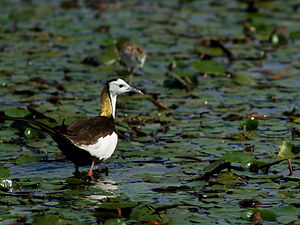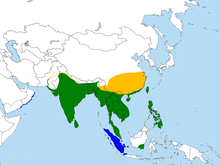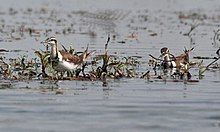Pheasants
| Pheasants | ||||||||
|---|---|---|---|---|---|---|---|---|

Pheasants in their splendor |
||||||||
| Systematics | ||||||||
|
||||||||
| Scientific name of the genus | ||||||||
| Hydrophasianus | ||||||||
| Wagler , 1832 | ||||||||
| Scientific name of the species | ||||||||
| Hydrophasianus chirurgus | ||||||||
| ( Scopoli , 1786) |
The pheasant flaccid ( Hydrophasianus chirurgus ) is a bird from the order of the plover-like (Charadriiformes) native to Southeast Asia . It is the only representative of the monotypic genus Hydrophasianus . Within the jacobes family , the pheasant jacobes stand out for their splendid dress , which, in contrast to the other species, differs significantly from the simple dress . In their splendid dress they have a long, pheasant-like tail, which has led to the name pheasant leaf chickens.
The IUCN classifies the pheasant leaf chick as not endangered ( least concern ) and estimates the population at 100,000 sexually mature individuals.
description
In the plain dress , the pheasant leaf chick reaches a body length of up to 31 centimeters, in the magnificent dress the body length is up to 58 centimeters due to the long tail. The wingspan is 67 centimeters. There is no pronounced sexual dimorphism , the females are only slightly larger than the males. The beak is blue-gray in both clothes. Some individuals have a yellowish beak base.
The head, forehead and front neck are white in the splendid dress. The neck is yellowish to orange-yellow and bordered by a thin black line. There is a large black spot at the base of the neck. The top of the body is dark brown. The wing covers are white. The tail is very long and black and curved like a pheasant. The legs and feet are gray, the toes extremely long. The iris is brown.
In the plain dress, the forehead, the top of the head, the back of the neck and the coat are reddish brown. A noticeable dark line runs from the base of the beak over the eye along the side of the neck. These converging lines form a band that is only vaguely defined on the chest. The sides of the neck are otherwise strong yellow-brown. The underside of the body is white. The iris is pale yellow.
Distribution area and habitat
The pheasant is a relatively common bird in larger wetlands with floating vegetation . The breeding areas include Pakistan , India , Nepal , Bangladesh , Sri Lanka , southeast Asia, southern China and Taiwan . The pheasant migrates within its breeding area to avoid drought. Its habitat are remote ponds, lakes and marshes .
The populations that breed in the north of the range move further south after the breeding season. They then come to Thailand , the Malay Peninsula , Sumatra and the Philippines and also reach Oman and Yemen . They occur as random visitors to Java , Bali , South Korea and western Australia , among others .
Way of life
In waters with abundant vegetation, such as water lilies , lotuses and water hyacinths , the bird walks with its long legs over water plants. The diet consists of plankton, larger invertebrates, amphibians and small fish.
In the mating season, usually between May and July, in southern India between June and September, a female mates with up to five males and lays two to six black-spotted brown eggs in each partner's floating nest. The males incubate the eggs and care for the nestlings. Mostly there is one brood per year, but sometimes two.
supporting documents
literature
- Colin Harrison, Alan Greensmith: Birds. Dorling Kindersly Limited, London 1993, 2000, ISBN 3-8310-0785-3 .
- Bryan Richard: Birds. Parragon, Bath, ISBN 1-4054-5506-3 .
- Richard Chandler: Shorebirds of the Northern Hemisphere. Christopher Helm Publishing House, London 2009, ISBN 978-1-4081-0790-4 .
Web links
- BirdLife International (2010) Species factsheet: Hydrophasianus chirurgus . Factsheet on the pheasant ligule, accessed on December 29, 2010
Single receipts
- ↑ Hydrophasianus chirurgus in the IUCN Red List of Threatened Species 2010.4. Retrieved December 29, 2010.
- ↑ BirdLife Factsheet on the pheasant , accessed December 20, 2010
- ^ A b Richard Chandler: Shorebirds of the Northern Hemisphere. Publishing house Christopher Helm, London 2009, p. 38.
- ^ Richard Chandler: Shorebirds of the Northern Hemisphere. Verlag Christopher Helm, London 2009, p. 38 and p. 39.


